Spinal Seating Modules
Keys to manual wheelchair configuration
The configuration of a manual wheelchair must achieve a balance between wheelchair stability, manoeuvrability and the preservation of the client’s upper limb function.
1. Wheelchair configuration for stability and manoeuvrability
Apart from the client’s postural and pressure management goals, the manual wheelchair should be configured to optimise stability and manoeuvrability for everyday function. Stability is necessary to ensure client safety and security in chair use. Manoeuvrability affects access to tight spaces and the ease of propulsion. Manoeuvrability and stability in the wheelchair can be altered by adjustment of the rear axle and the front castor positions in relation to the centre of mass of the wheelchair and client.
Stability in relation to manual wheelchair seating can relate to a number of characteristics including:
- The resistance the chair has to being tipped rearwards into a wheelstand
- The resistance the chair has to tipping forwards or sideways, and
- The capacity for the seating to support the client’s seating posture throughout typical daily use.
Manoeuvrability in the wheelchair typically refers to a combination of characteristics including:
- The overall ability of the chair to navigate around tight spaces
- The ease with which the speed of the chair can be changed, and
- The ease with which the direction of the chair can be changed.
A very stable wheelchair would minimise risk of the user tipping out of the wheelchair rearward, forward or laterally during propulsion and activities. However such a wheelchair configuration would have a long wheelbase, reduced manoeuvrability and be difficult when trying to raise the front castors for climbing gutters or descending a slope or kerb.
A very manoeuvrable wheelchair would fit into tight spaces and be very responsive to the user in rolling, turning and performing a wheelstand. However such a wheelchair configuration may be insufficiently stable for safe use by clients:
- With limited wheelchair skills
- Wheeling up inclines or ramps
- Propelling over high friction floors (such as carpet), or
- Initiating propulsion from a standing start.
In practice an appropriate wheelchair configuration for a given client should balance their need for stability and manoeuvrability. As there is a fine balance between stability and manoeuvrability, wheelchair configuration should be assessed for indoor activities and outdoor use in various environments, and should also be reviewed over time according the changes in the client’s wheelchair skills, experience and health status (e.g. adjusting axle position to compensate for weight gain or loss).
Note
Configuring the rear axle position rearwards to make the chair increasingly stable reduces propulsion efficiency which increases the long term risk of injury to the upper limbs (see section on ‘Upper limb pain’ above). In some cases it may be necessary to consider alternate strategies to accommodate a client’s needs (e.g. anti-tips to compensate for ‘tippiness’ or propulsion-assist to reduce upper limb strain.
For first-time wheelchair users, it is prudent to prescribe a wheelchair with adjustable stability, which is initially configured to a stable condition. Once the client’s confidence, wheelchair skills and seating balance have improved the configuration can be altered to improve manoeuvrability.
A wheelstand (‘wheelie’) is a controlled technique for balancing on the rear wheels of the wheelchair while the castors are raised from the ground. It can be a momentary activity to lift the front castors over an obstacle or sustained for a period of time for the client to maintain an upright posture while descending a ramp or kerb. It is both more difficult and less safe to perform and maintain a wheelstand if the chair is too stable.
For experienced wheelchair users, configure the wheelchair for efficiency and manoeuvrability to provide the optimal wheelchair propulsion pattern both indoors and outdoors which should minimise strains in the upper limb long term. Clients with a long experience in wheelchair use may elect to have a wheelchair with less adjustment to reduce the weight of the wheelchair and maintenance issues.
A. Horizontal adjustment of the rear axle position
- PVA Recommendation #8:
- Adjust the rear axles as far forward as possible without compromising the stability of the user.
When a client is sitting in their wheelchair their weight (as well as the weight of the chair and any baggage) is transferred through the chair and into the wheels (rear wheels and castors). The position of the rear wheel relative to the client’s centre of gravity affects the proportion of weight supported by the rear wheels. The client can also adjust the position of their centre of gravity by sitting further forwards or rearwards on their seat or by leaning forwards or backwards. The further rearward the client’s centre of gravity, the more weight the rear wheels support (the less weight the castors need to support). Reducing the amount of weight to the front castors typically makes the chair roll more easily, especially over soft ground.
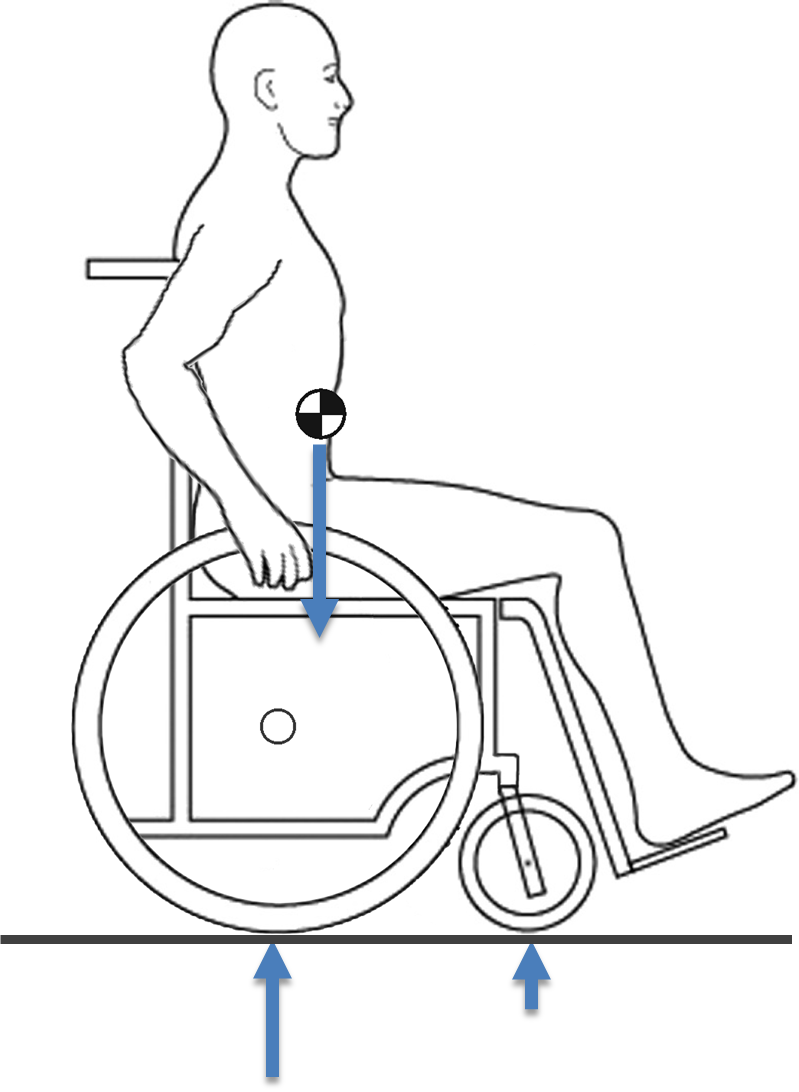
Rear axle set forwards
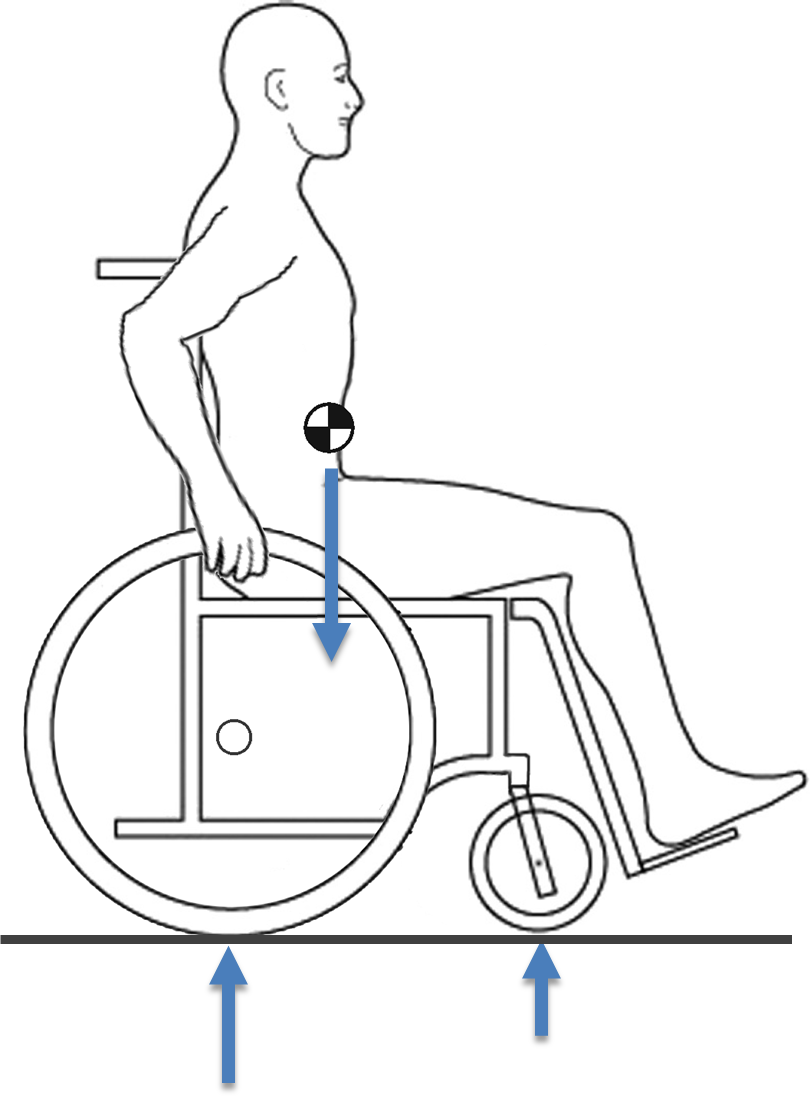
Rear axle set midway
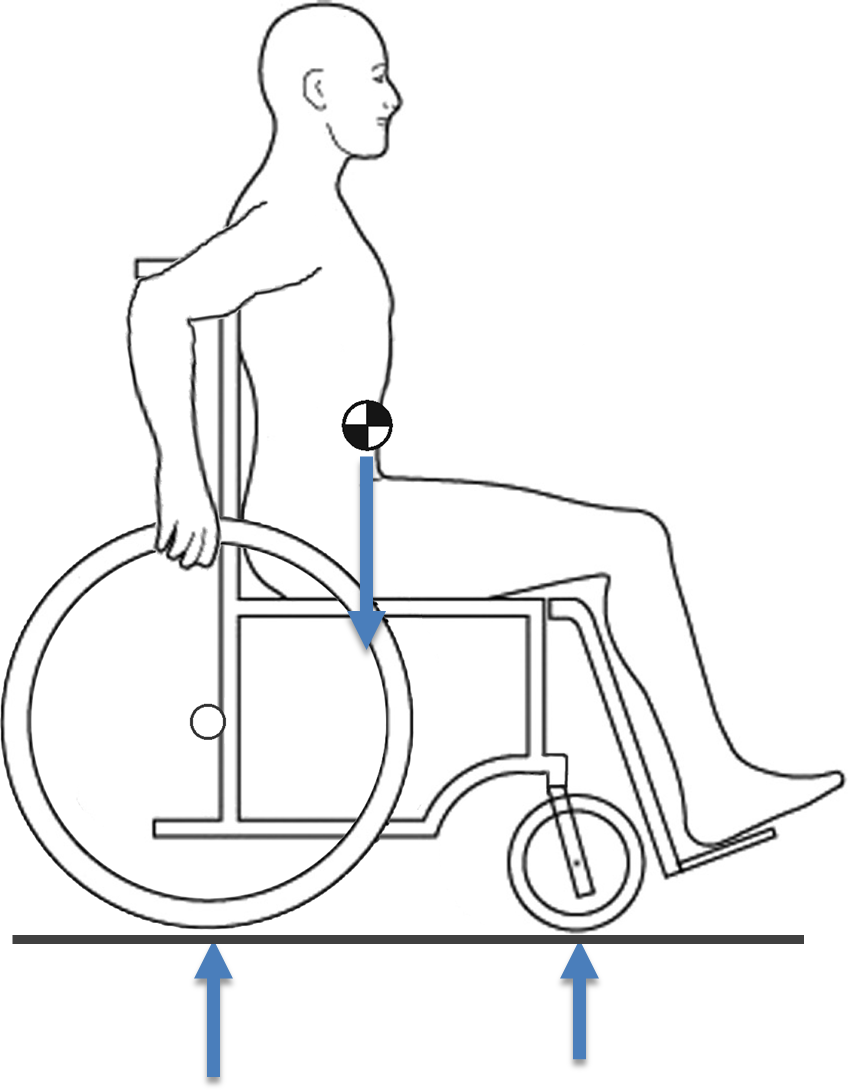
Rear axle set rearwards
Figure 1: Diagrams showing the balance of forces relative to rear axle position.
Original images used with permission from Sprigle, S.1 Adapted by Brown, I. 2016.
When trying to perform a wheelstand the rear wheel axle of the chair acts as a pivot point. To raise the castors from the ground, clients generally push briskly against the wheels to provide the necessary tipping force. With the rear wheel axle position adjusted forwards less force is required to tip the chair. Setting the rear wheel position too far forwards can make the chair very ‘tippy’ and may be dangerous for clients with limited upper limb function or sense of balance; in some cases anti-tip bars are required for safe wheelstands. In a steady wheelstand position only a little force is required to maintain the wheelstand, although beginners may lack the confidence and control to achieve this. When a wheelstand is maintained in the balanced tipped position the centre of gravity of the client (including baggage and the chair) is directly above the rear wheel axle.
Starting a wheelstand
A sharp forward push on the wheels needs to be sufficient to raise the castors from the ground.
Maintaining a wheelstand
The user’s hands must remain on the rear wheels and constantly correct the balance to prevent the chair from falling forwards or backwards.
Forward-set rear axle
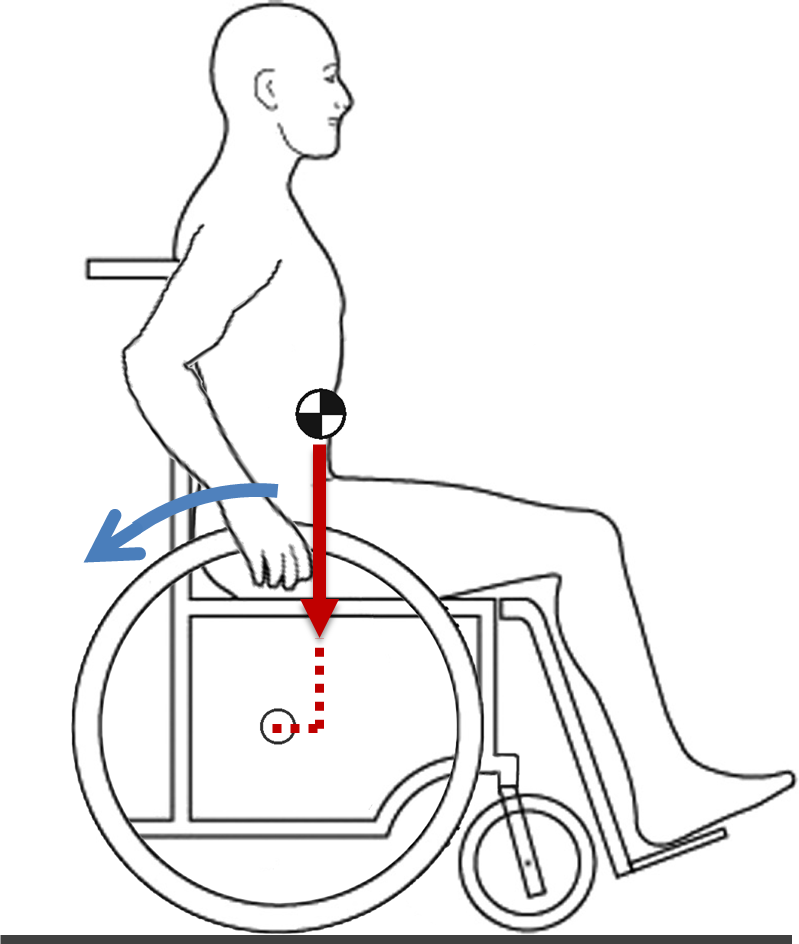

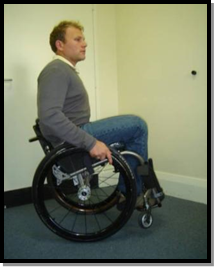
A chair with a rear axle set forwards requires little effort to tip into a wheelstand but practiced skill to control. When sitting normally the castors may only be a little way off the ground in the balanced tipped position (75-100mm). To raise the castors higher, such as for climbing a kerb, the client must adjust their centre of gravity forwards (e.g. by leaning) or control the balance of the chair through the force they are applying to the rear wheel.
A more forward rear axle position reduces the chairs wheelbase which will improve accessibility and manoeuvrability but be less stable.
Rearward-set rear axle



A chair with the rear axle set a long way back requires much more effort to tip. Greater effort is required to do a wheelie or to maintain a wheel stand to keep castors off the ground. The castors need to be lifted further off the ground to reach the balanced tipped position.
A rearward axle position lengthens the chair’s wheelbase which will make the chair more stable but reduce manoeuvrability.
Figure 2: Diagrams showing the torque required to start and maintain a wheelstand1.
Original line drawings used with permission from Sprigle, S.1. Adapted by Brown, I. 2016.
B. Roll resistance
Factors that affect the rolling resistance (effort to initiate and maintain rolling) include:
- Combined weight of the client, seating system and wheelchair – more effort is required with a heavier system
- Weight distribution between front castors and rear wheels – more effort is required when the front castors are heavily loaded, which happens when the client’s weight is too far towards the front of the chair
- Selection of tyres
- Tyre type: Pneumatic rear tyres are easier to push than ‘solids’. A correctly inflated pneumatic tyre rolls more easily than an under inflated tyre.3 Many clients avoid pneumatic castor tyres because they are troublesome and puncture easily
- Tyre size: On hard ground narrow tyres roll more easily and on soft ground wide tyres roll more easily
Some clients elect to have two sets of rear wheels with appropriate tyre treads for indoor and outdoor use. Note that the wheel locks may need to be adjusted each time the rear wheels are changed for the brakes to be effective.
- The surface over which the wheelchair is travelling (e.g. hard surface, carpet)
- Regular maintenance of the wheelchair can reduce roll resistance. Clients should be encouraged to ensure axles and axle pins must be cleared of hair and cotton to reduce friction. Castor and rear wheel alignment should be checked, and
- Warping of the wheelchair frame due to wear or damage (typically folding frame wheelchairs) can increase rolling resistance.
References
- Sprigle, S. 2014. Measure it: Proper wheelchair fit is key to ensuring function while maintaining skin integrity. Advances in Skin and Wound Care. Wolters Kluwer Health, Lippincott, Williams and Wilkins. Available online from CIAP: http://ee6qx5bs9t.scholar.serialssolutions.com/?sid=google&auinit=S&aulast=Sprigle&atitle=Measure+It:+Proper+Wheelchair
+Fit+Is+Key+to+Ensuring+Function+While+Protecting+Skin+Integrity&id=pmid:25396675 Accessed: 07/03/2016 - Sawatzky, B.J., Kim, W.O., & Denison, I., 2004. The ergonomics of different tyres and tyre pressure during wheelchair propulsion. Ergonomics. 2004 ; 47 ( 14 ): 1475-1483.
- Babinec, M. 25 Configuration choices for efficient wheelchair propulsion [Internet]. Invacare; no date. [cited Oct 2015] Available from: https://www.scribd.com/document/147400440/25-Configuration-Choices-for-Efficient-Wheelchair-Propulsion
- Sprigle, S & Huang M. The Impact of Manual Wheelchair Design & Configuration on Propulsion Torque. Assistive Technology ; 2015. http://gyroconference.event123.no/NAV/NordicSeatingSymposium2015/pop.cfm?FuseAction=Doc&pAction=View&pDocumentId=63042
- Requeio, P.S., Furumasu, J., & Mulroy, S.J., 2015. Evidence-Based Strategies for Preserving Mobility for Elderly and Aging Manual Wheelchair Users [Internet]. Topics in Geriatric Rehabilitation: 2015 [12 Oct, 2015]: 31;1 : 26-41. Available from: https://www.researchgate.net/publication/271726655_Evidence-Based_Strategies_for_Preserving_Mobility_for_Elderly_and_Aging_Manual_Wheelchair_Users. DOI: 10.1097/TGR.000000000000004
- McKeogh, D.M., 2007. The anatomy of a manual wheelchair [Internet]. Sacramento; 2007 [Oct 2015]. Available from: http://www.csus.edu/indiv/m/mckeoughd/WC%20Anatomy/wcAnat%20wo%20animation.ppt
- Babinec, M. Translating Evaluation Measurements to Wheelchair Dimensions [Internet]. Invacare; no date. [cited Oct 2015]. Available from: http://www.invacare.com.au/index.cfm/3,168,522/measurements-to-wc-geometries.pdf
- Queensland Spinal Cord Injuries Service. Manual wheelchair: information resource for service providers [Internet]. Queensland Spinal Cord Injuries Service; 2013 [cited Oct 2015]. Available from: https://www.health.qld.gov.au/qscis/documents/manual-wheelchairs.pdf